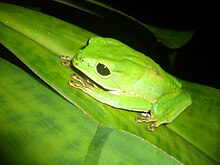Phyllomedusa camba
| Phyllomedusa camba | |
|---|---|

| |
| Scientific classification | |
| Domain: | Eukaryota |
| Kingdom: | Animalia |
| Phylum: | Chordata |
| Class: | Amphibia |
| Order: | Anura |
| Family: | Phyllomedusidae |
| Genus: | Phyllomedusa |
| Species: | P. camba
|
| Binomial name | |
| Phyllomedusa camba (De la Riva, 1999)
| |
| Synonyms[2] | |
| |
The black-eyed monkey frog (Phyllomedusa camba) is a frog that lives in Bolivia, Peru, and Brazil.[2] Scientists have seen it up in the mountains, between 280 and 1000 meters above sea level.[3][1]
The adult frog is 60.8 mm (2.39 in) to 69.6 mm (2.74 in) long from nose to rear end. It has disks on its toes for climbing. This frog is green with yellow marks around its eyes. It has pink-white spots on its sides and white spots on the insides of its legs. Parts of its legs and middle are purple.[3]
This frog hides during the day and looks for food at night. The frogs live in forests that have never been cut down and in forests that are growing back. When it is time to lay eggs, the frogs leave the forest and go to a swamp if they can.[3] The female frog makes a nest out of foam on a leaf. When the eggs hatch, they fall into the water below.[1]
Scientists say this frog is not in danger of dying out because it lives in such a large place and because, they think, it is good at living in places that humans have changed.[1]
The scientific name of this frog, "camba," comes from the indigenous people who live in Bolivia.[3]
References
[change | change source]- ↑ 1.0 1.1 1.2 1.3 IUCN SSC Amphibian Specialist Group (2023). "Black-eyed Monkey Frog: Pithecopus camba". IUCN Red List of Threatened Species. 2023. The IUCN Red List of Threatened Species: e.T154108581A61405739. doi:10.2305/IUCN.UK.2023-1.RLTS.T154108581A61405739.en. Retrieved January 26, 2024.
- ↑ 2.0 2.1 Frost, Darrel R. "Phyllomedusa camba (De la Riva, 1999)". Amphibian Species of the World, an Online Reference. Version 6.0. American Museum of Natural History. Retrieved September 4, 2021.
- ↑ 3.0 3.1 3.2 3.3 David Wong (February 13, 2013). "Phyllomedusa camba". AmphibiaWeb. Amphibiaweb. Retrieved September 4, 2021.

